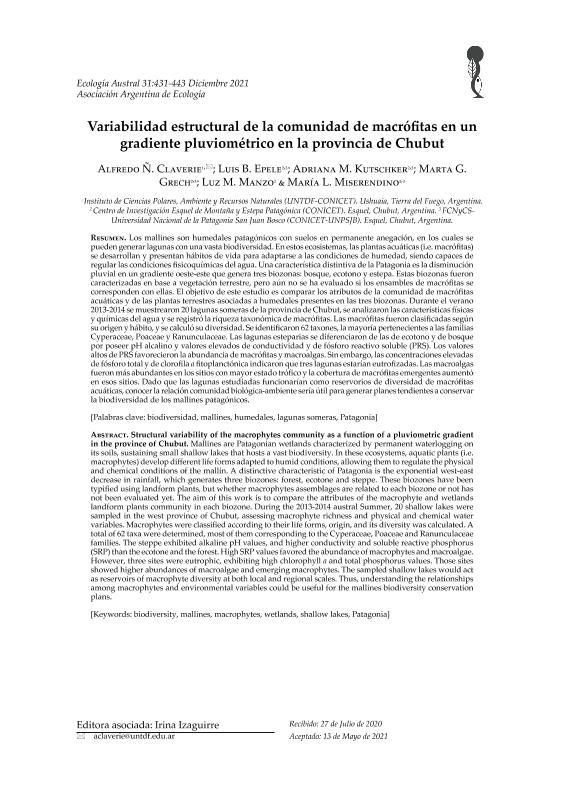Artículo
Los mallines son humedales patagónicos con suelos en permanente anegación, en los cuales se pueden generar lagunas con una vasta biodiversidad. En estos ecosistemas, las plantas acuáticas (i.e. macrófitas) se desarrollan y presentan hábitos de vida para adaptarse a las condiciones de humedad, siendo capaces de regular las condiciones fisicoquímicas del agua. Una característica distintiva de la Patagonia es la disminución pluvial en un gradiente oeste-este que genera tres biozonas: bosque, ecotono y estepa. Estas biozonas fueron caracterizadas en base a vegetación terrestre, pero aún no se ha evaluado si los ensambles de macrófitas se corresponden con ellas. El objetivo de este estudio es comparar los atributos de la comunidad de macrófitas acuáticas y de las plantas terrestres asociadas a humedales presentes en las tres biozonas. Durante el verano 2013-2014 se muestrearon 20 lagunas someras de la provincia de Chubut, se analizaron las características físicas y químicas del agua y se registró la riqueza taxonómica de macrófitas. Las macrófitas fueron clasificadas según su origen y hábito, y se calculó su diversidad. Se identificaron 62 taxones, la mayoría pertenecientes a las familias Cyperaceae, Poaceae y Ranunculaceae. Las lagunas esteparias se diferenciaron de las de ecotono y de bosque por poseer pH alcalino y valores elevados de conductividad y de fósforo reactivo soluble (PRS). Los valores altos de PRS favorecieron la abundancia de macrófitas y macroalgas. Sin embargo, las concentraciones elevadas de fósforo total y de clorofila a fitoplanctónica indicaron que tres lagunas estarían eutrofizadas. Las macroalgas fueron más abundantes en los sitios con mayor estado trófico y la cobertura de macrófitas emergentes aumentó en esos sitios. Dado que las lagunas estudiadas funcionarían como reservorios de diversidad de macrófitas acuáticas, conocer la relación comunidad biológica-ambiente sería útil para generar planes tendientes a conservar la biodiversidad de los mallines patagónicos. Mallines are Patagonian wetlands characterized by permanent waterlogging on its soils, sustaining small shallow lakes that hosts a vast biodiversity. In these ecosystems, aquatic plants (i.e. macrophytes) develop different life forms adapted to humid conditions, allowing them to regulate the physical and chemical conditions of the mallín. A distinctive characteristic of Patagonia is the exponential west-east decrease in rainfall, which generates three biozones: forest, ecotone and steppe. These biozones have been typified using landform plants, but whether macrophytes assemblages are related to each biozone or not has not been evaluated yet. The aim of this work is to compare the atributes of the macrophyte and wetlands landform plants community in each biozone. During the 2013-2014 austral Summer, 20 shallow lakes were sampled in the west province of Chubut, assessing macrophyte richness and physical and chemical water variables. Macrophytes were classified according to their life forms, origin, and its diversity was calculated. A total of 62 taxa were determined, most of them corresponding to the Cyperaceae, Poaceae and Ranunculaceae families. The steppe exhibited alkaline pH values, and higher conductivity and soluble reactive phosphorus (SRP) than the ecotone and the forest. High SRP values favored the abundance of macrophytes and macroalgae. However, three sites were eutrophic, exhibiting high chlorophyll a and total phosphorus values. Those sites showed higher abundances of macroalgae and emerging macrophytes. The sampled shallow lakes would act as reservoirs of macrophyte diversity at both local and regional scales. Thus, understanding the relationships among macrophytes and environmental variables could be useful for the mallines biodiversity conservation plans.
Variabilidad estructural de la comunidad de macrófitas en un gradiente pluviométrico en la provincia de Chubut
Título:
Structural variability of the macrophytes community as a function of a pluviometric gradient in the province of Chubut
Claverie, Alfredo Ñancuche ; Epele, Luis Beltran
; Epele, Luis Beltran ; Kutschker, Adriana Mabel; Grech, Marta Gladys
; Kutschker, Adriana Mabel; Grech, Marta Gladys ; Manzo, Luz Maria
; Manzo, Luz Maria ; Miserendino, Maria Laura
; Miserendino, Maria Laura
 ; Epele, Luis Beltran
; Epele, Luis Beltran ; Kutschker, Adriana Mabel; Grech, Marta Gladys
; Kutschker, Adriana Mabel; Grech, Marta Gladys ; Manzo, Luz Maria
; Manzo, Luz Maria ; Miserendino, Maria Laura
; Miserendino, Maria Laura
Fecha de publicación:
08/2021
Editorial:
Asociación Argentina de Ecología
Revista:
Ecología Austral
ISSN:
1667-7838
e-ISSN:
0327-5477
Idioma:
Español
Tipo de recurso:
Artículo publicado
Clasificación temática:
Resumen
Palabras clave:
BIODIVERSIDAD
,
MALLINES
,
HUMEDALES
,
LAGUNAS SOMERAS
,
PATAGONIA
Archivos asociados
Licencia
Identificadores
Colecciones
Articulos(CIEMEP)
Articulos de CENTRO DE INVESTIGACION ESQUEL DE MONTAÑA Y ESTEPA PATAGONICA
Articulos de CENTRO DE INVESTIGACION ESQUEL DE MONTAÑA Y ESTEPA PATAGONICA
Citación
Claverie, Alfredo Ñancuche; Epele, Luis Beltran; Kutschker, Adriana Mabel; Grech, Marta Gladys; Manzo, Luz Maria; et al.; Variabilidad estructural de la comunidad de macrófitas en un gradiente pluviométrico en la provincia de Chubut; Asociación Argentina de Ecología; Ecología Austral; 31; 3; 8-2021; 431-443
Compartir
Altmétricas



